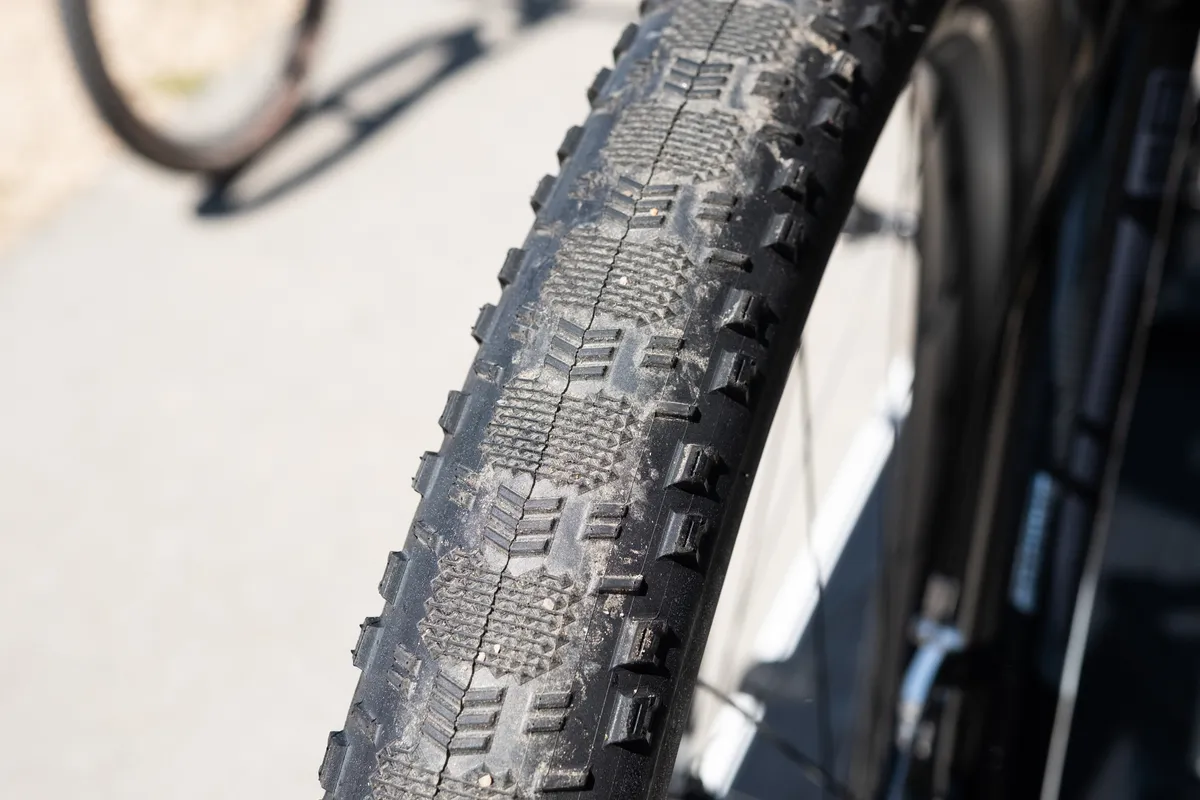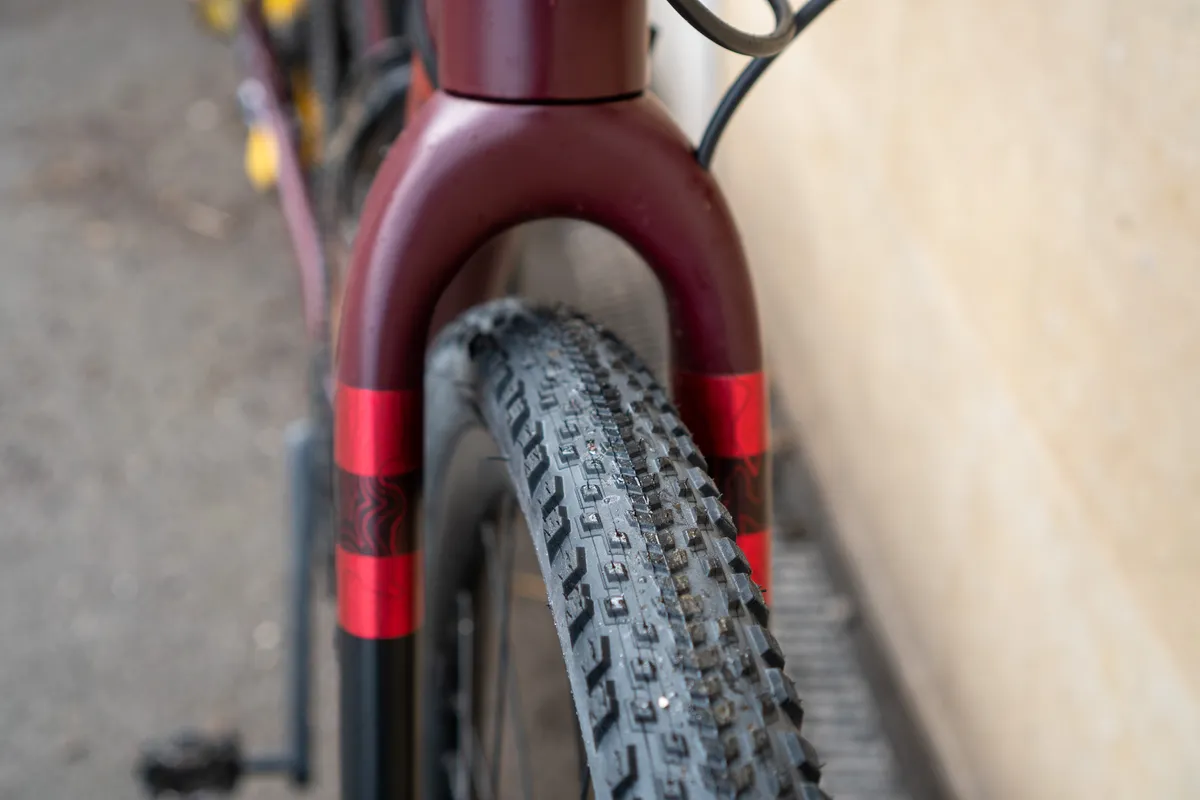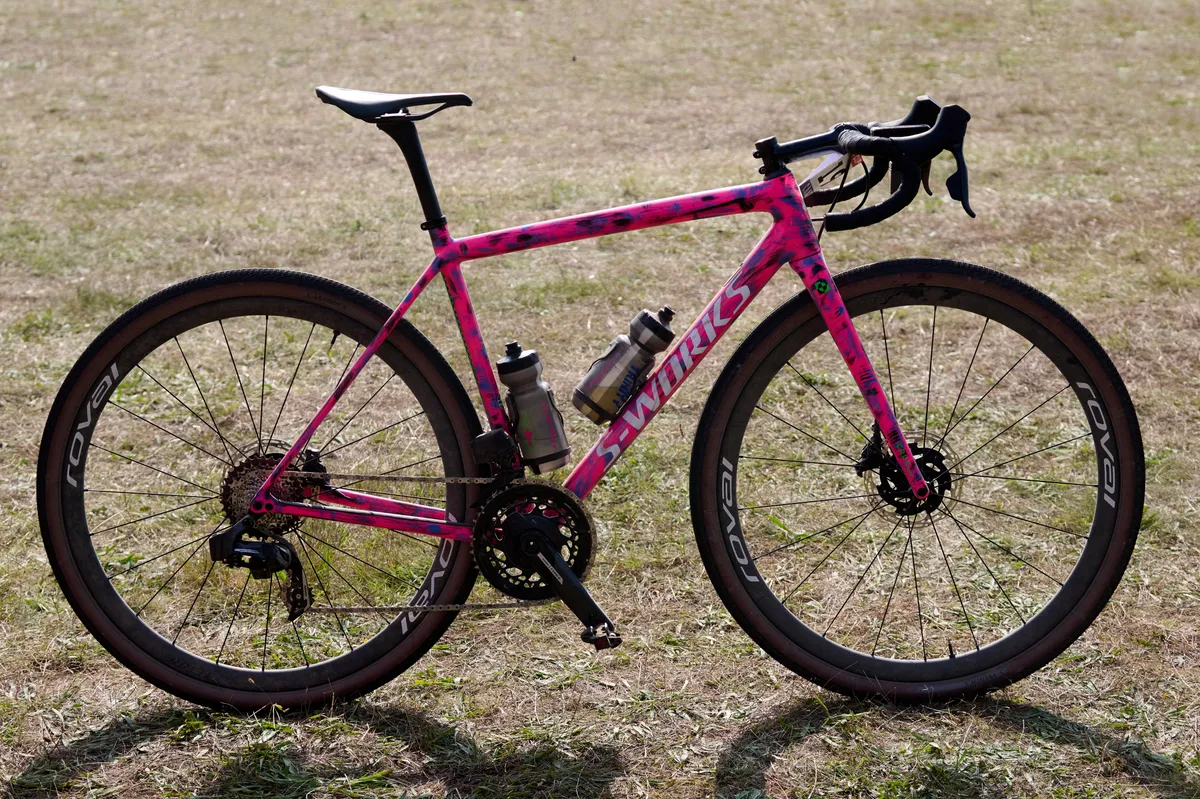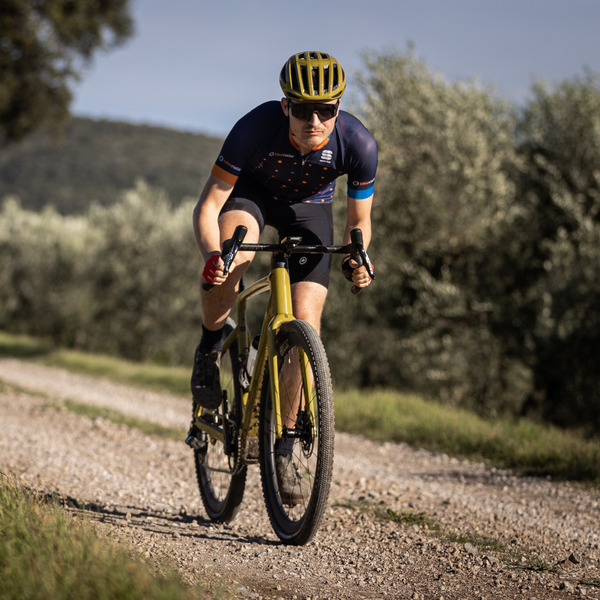It felt like only yesterday when a 40mm gravel bike tyre was considered wide, but that very quickly increased to 45, then 50mm.
However, the trend in 2025 has been for brands to push the boundaries even further, with some new bikes sporting clearances in excess of 57mm, enabling you to run a cross-country mountain bike tyre on a gravel bike.
And judging from the bonanza of unreleased bikes being raced at Unbound 2025, it looks as though there are a lot more on the horizon.
Is 57mm+ set to become the new gravel bike tyre standard, or are manufacturers taking things too far?

In this article, we’ll take a look at the trend for how wider tyre clearances have come about and whether it’s likely to be the future.
We’ll also hear from three manufacturers – Lauf, 3T and Ridley – about why they’re embracing the trend, with Specialized and Trek weighing in on why they haven’t joined the bandwagon (or at least not yet).
A brief history of tyre clearances
Although some may argue Paris-Roubaix or early editions of the Tour de France that began on unpaved dirt roads symbolised the start of gravel, early gravel races prior to 2010 would typically be ridden on cyclocross bikes.
These had the widest tyre clearance of drop-bar bikes at the time, with riders typically running 30 to 35mm tyres, although tyres were strictly limited to 33mm for UCI-sanctioned races.
Between 2010 and 2015, as the term ‘gravel’ started to enter the lexicon, tyre clearances expanded to between 35 and 40mm, with notable releases such as the Salsa Warbird and Kinesis Tripster. In 2014, WTB rolled out its first gravel tyre, the Nano 40, and followed this the next year with a whole variety of allroad and gravel tyres.
Gravel exponentially rose in popularity after 2015, with gravel bikes morphing closer to what they are today. With that, tyre clearances expanded again, this time to between 40 and 45mm on 700c wheels. Manufacturers also flirted with 650b wheels, with one such memorable example being the Cannondale Slate, which came with 650b x 42mm tyres.
From 2020 to the present day, gravel bike tyres have got progressively wider once – to between 45 and 50mm.
Is this the end, or are we on the frontier of seeing another shift towards even wider rubber?
Why are manufacturers stepping up to 57mm tyres?

Lauf’s Seigla was notable when it was released in April 2022, offering clearance for up to 700c x 57mm (or 29x2.25in) tyres. By comparison, Lauf's previous gravel bike – the True Grit – only had clearance for 45mm rubber.
Benedikt Skúlason, Lauf’s founder and CEO, says “our reasoning behind opting for a wider clearance is that it [makes for] a smoother and faster [ride].” Skúlason explains he was originally inspired by the racing scene, citing a popular event called the Blue Lagoon Challenge in his native Iceland (which sadly no longer runs due to bi-monthly volcanic eruptions that have now buried the course).
He says the race was “more like a modern gravel bike event before there were gravel bikes” and it’s the kind of course where you can never run too wide a tyre. Skúlason reckoned most riders would turn up on hardtail mountain bikes with tyres between 2 and 2.25in-wide.
“Our philosophy behind the Seigla was to keep the ride feel of the True Grit but with more compliance at the back, with more tyre clearance, while sticking to 425mm chainstays,” Skúlason explains.
Lauf was certainly onto something, although for a while the Seigla proved an intriguing outlier in the melting pot of gravel releases.

3T’s Extrema Italia was then released in November 2023, sporting an identical 57mm clearance. However, the Extrema Italia proved a very different proposition from the Seigla, with the frame full of the 3T’s signature aerodynamic touches – a monster aero gravel bike, if you will.
Andrea Bortolin, product manager at 3T, explains the Extrema Italia was “engineered and developed for tough races and fast adventures” and that tyres are critical in developing “the best and fastest possible gravel bike”.
3T differs from other manufacturers in that it tests and measures tyres by two metrics – WAM (width as measured) and RAM (radius as measured – the total tyre’s radius measured from the centre of the hub axle).
Bortolin explains: “The real tyre measurement is the key and is dependent on the rim used, tyre pressure and how accurate the manufacturer’s claimed size is.”
He says 3T extensively tested many tyres and “took hundreds of measurements to know the real tyre widths”, coming to the conclusion that “the ideal tyre range for the toughest terrain at high speed and for long distances is to have tyres that measure more than 50mm WAM”.
As such, 3T recommends the use of tyres between 50 and 57mm WAM for the Extrema Italia.
The Extrema Italia quickly became the weapon of choice of many of 3T’s sponsored gravel riders, with Alex Martínez winning the 2024 edition of Badlands aboard the bike, arguably Europe’s most notable gravel ultra-endurance race.
With the Lauf Seigla and 3T Extrema Italia both ahead of their time, there has been a sudden influx of new releases in 2025, sporting identical or sometimes greater tyre clearances.

Recently launched examples include the Allied Able and Argon 18 Dark Matter, with Ridley’s Ignite GTX taking things a step further to 58mm (29x2.3in), and the Lee Cougan Innova Super Gravel 61mm (2.4in).
Bert Kenens, R&D manager at Ridley, was refreshingly candid when asked why the brand launched the Ignite GTX.
“We have developed the Ignite GTX starting from our Ignite SLX hardtail frame platform because we saw a growing number of consumers converting their mountain bikes to a gravel bike for more technical and rougher terrain,” he says.
“Since there are very few bikes available on the market with this setup as standard specification, the Ignite GTX is an answer to this market demand, even if it might only be a niche segment.”
This desire to cater to market demands is undoubtedly what has caused other brands to embrace the trend – and will be the deciding factor in whether more mainstream manufacturers get on board, too.
1x drivetrains have paved the way

1x drivetrains, where a single-ring chainring is used without a front derailleur, have undoubtedly been a factor as to why tyre clearances have evolved. This is because there’s no front derailleur to get in the way of the tyre.
Although 1x drivetrains are not new, SRAM launched its first dedicated cyclocross-oriented Force CX1 in 2014, and Shimano and Campagnolo have since brought out their own GRX and Ekar options respectively.
As such, while some gravel riders are still content using a 2x drivetrain, 1x rules the roost.

Incidentally, though, 3T’s Extrema Italia is one of the only examples in this latest crop of bikes with 57mm tyre clearance to allow compatibility with a front derailleur.
Bortolin acknowledges some riders still prefer a 2x option but “a 1x groupset is what we recommend to get the best out of a 3T frame [...] and if a 2x setup is chosen, then it is not the frame that limits the tyre size but the front derailleur”.
Testing, testing

When it comes to how manufacturers have settled on their specific clearances, Lauf, 3T and Ridley have each taken a different approach.
Lauf says it didn’t develop the Seigla with any specific tyres in mind, with Skúlason instead saying “testing single tyres has misleading errors” and instead relied on the “fundamental physics” behind the theory of running wider tyres.
Bortolin says 3T carried out extensive testing with a whole range of tyres on a wide variety of different rims. He says “generally speaking, there is not a big difference in rolling resistance between a 45mm and a 55mm tyre, assuming they have the same tread pattern, on very smooth terrain” and that more power is required by a rider running wider tyres as the speed increases.
However, when the terrain becomes rougher, Bortolin says wider tyres have a higher advantage, even as the speed increases, summarising that “on tough terrain, 50-55mm tyres are generally faster than 40-45mm”.

This is why 3T has two gravel bikes in its range – the RaceMax Italia with a 40 to 46mm WAM tyre, recommendation for smoother courses, and the Extrema Italia for the gnarliest gravel.
Kenens says Ridley hasn’t undertaken any specific lab testing of the Ignite GTX’s 2.3in tyres compared to 40 to 45mm tyres, saying the “choice is more inspired by the extra comfort and traction these tyres will offer the rider on technical terrain”.
A fad or a trend?

Although there have been a number of manufacturers jumping on the 57mm bandwagon, not all new releases have tyre clearances that generous.
Notable 2025 bikes with more conventional clearances include the Niner ORE 9 RDO and Norco Search XR, both of which top out at 50mm.
And then, there are existing bikes such as the Trek Checkmate and Cervélo’s new Áspero 5, both of which top out at only 45mm tyre clearance.
Are we in a transitionary moment in time where everything is about to go wide, or are 57mm+ clearances not the way forward?

Skúlason, Bortolin and Kenens all think 57mm+ tyres are going to become a trend, with Skúlason saying “a wider tyre is optimal when the surface gets worse” and that a rider’s logic when selecting a tyre should be “what is the fastest width rather than what is the narrowest I can get away with?”.
Does that mean there are a number of gravel bikes on the market that are effectively out of date on release with their lesser clearances?
While Kenens says he wouldn’t go as far as to use the word ‘outdated’, he says “existing frames [with lesser clearances] are certainly not future-proofed”.
Bortolin says there is more nuance to this question and that “the key is to choose a bike which is the right fit for the rider’s needs” citing, for example, its RaceMax Italia as being a better option for smoother gravel.
How are mainstream manufacturers going to respond?

Skúlason says bigger brands are going to react.
“These brands know [the benefits of wider tyres] and are excited by it themselves but by their nature, they cannot react as fast,” he says. “When a brand is that big, it has to play according to the demand of its dealers and customers, whereas smaller brands can do whatever they want.”
We asked Specialized and Trek what they are doing to assess the market on the emerging trend of 57mm+ tyre clearances and whether it’s something they’re looking to explore with future models.
Specialized responded, saying “we are always monitoring trends in the gravel space, including tyre clearance”, but declined whether this was something it was actively pursuing on a future model. We spotted what appears to be a new Diverge at Unbound 2025 and are excited to see whether this embraces the trend.
Jordan Roessingh, Trek’s global director, gave a far more detailed answer. He says: “The rate of change of gravel bike tyre sizes over the past 12 to 24 months has been pretty extraordinary. It seemed reasonable one or two years ago to race Unbound on a 38 to 42mm tyre, but the vast majority of the pros this year were running tyres bigger than 45mm – 50mm, 2in, or 2.2in was the norm.”

Roessingh continues: “Trek is very aware of this trend, and has been conducting a significant number of studies to better understand the performance implications of bigger tyres,” but acknowledges there is minimal research and scientific rigour in terms of current research.
He says brands and riders are instead relying on “a lot of anecdotes and YouTube scientists out there that are driving the trend”.
At Unbound 2025, Roessingh explains, Trek conducted tests on different sections of the course, “testing multiple tyre sizes at different pressures, measuring vibration, power, speed, and O2 consumption, and subjective ride feedback. We also 3D-scanned the surfaces so that we can correlate the measured data to the specific surface conditions, and apply the surface roughness to our treadmill for more controlled future studies.”
Roessingh says the aim of the testing is to have a more data-driven approach to what size tyres and pressures riders should run on different courses and their respective conditions.

He also makes an interesting point that pros and amateur races are ridden very differently.
“Talking to the pros, the race is such a big fight for position, and so continuously fast, that riders are forced to take non-optimal line choices to position themselves, or ride at high speeds completely blind to obstacles on the trail because they are so close behind the next riders,” he says. “Riders need setups that can manage those alternate lines, or blind hits to big rocks without puncturing or damaging a wheel. For them, big tyres are more for safety/risk management than for speed.”
As for the amateurs, Roessingh explains they don’t ride with as much urgency. “They are going dramatically slower, and can pick their way around the same obstacles that the pros are nailing head-on,” he says. “Risk management is still at play, and comfort is a concern, but the motivations are different.”
As such, Trek certainly hasn't ignored this emerging trend, with Roessingh saying “how far we go on tyre clearance on future models will largely be an outcome of this effort”.

Since speaking to Roessingh, we’ve spotted what appears to be a new full-suspension Trek gravel bike being ridden by esteemed ultra-racer Justinas Leveika at this year’s Trans Balkan Race.
Like Specialized, it seems a Trek bike with wider tyre clearance that embraces the trend for wider tyres could soon be on the horizon.
At what point do gravel bikes with 57mm+ clearances become drop-bar mountain bikes?

If the comments sections of BikeRadar articles are anything to go by, many have drawn on the similarities between today’s evolving gravel bikes and mountain bikes of the 1990s.
Skúlason and Kenens both say gravel bikes with 57mm+ clearances are not just drop-bar mountain bikes, both suggesting the geometry is the distinguishing factor in terms of how a bike handles.
This is also a view supported by Bortolin, who says the stack will be a little higher for greater control and there is a balancing act between a bike feeling confident on rough terrain but still light and nimble on faster sections with the bigger-volume tyres.
He says the Extrema Italia definitely doesn’t have a mountain bike geometry, instead outlining “it has a similar grip to top-of-the-line cross-country mountain bikes but with a much faster rider position”.
Should gravel race bikes have tighter clearances than gravel bikes designed for more technical terrain?

By and large, the bikes that tend to have narrower clearances are designed for racing – but should this be the case? This question generated some interesting debate between the brands.
Skúlason firmly disagrees with this sentiment and says “race bikes with needlessly narrow tyre clearances are just silly and the only upside of them was that you could run a 2x drivetrain. But now that 1x13 exists, there’s no good reason”, concluding “having less clearance than 57mm is inferior”.
He goes on to explain how “there’s no weight penalty” for a race bike having wider tyre clearances, and says a frameset with sufficient clearance enables you to “pick the tyre you want. It doesn’t become more aero or anything [to have a bike with less generous clearances], if anything it might actually be more aero [to have wider clearances]”.
Skúlason theorises: “the real reason those bikes exist is so you can have an endless amount of SKUs (stock keeping unit) so you can cater to every niche. But from a physics perspective, I can’t see the point.”
The rest of the manufacturers are firmly in the other camp, but before we move on to their opinions, Skúlason’s view isn’t a singular voice.

For example, the second-generation Allied Able is an unapologetic race bike, eschewing mounting points for bikepacking, for example, in its quest for speed. Yet it has clearance for 57mm tyres based on testing the brand has conducted.
Bortolin thinks there is a place for gravel bikes with lesser clearances, concluding “a single bike cannot excel on every terrain. That’s why 3T offers road bikes and different gravel bikes, each developed for a different category”.
Ridley takes things further, having no fewer than eight models in its gravel bike range to cater to different niches. Kenens says Ridley “believes that the frame geometry is more important to determine how one categorises a bike” and believes tyre clearance is a feature you can add to a frame for it to suit the type of terrain it’s intended for.
Heading more mainstream, Specialized’s view aligns with 3T and Ridley’s.

The brand says “we believe riders should be able to choose their features best suited to the terrain they’re riding. Take our Diverge and Crux bikes for example; Diverge offers class-leading compliance, capability, and confident/stable handling to handle epic adventures and the roughest races, while Crux delivers class-leading weight, reactive and stable handling, and unmatched simplicity.”
This is a view shared by Trek, with Roessingh saying “it’s a reasonable argument that an adventure bike should have more clearance than a race bike due to a number of factors, such as comfort, reliability, control and exposure to rougher terrain”.
Roessingh then goes on to say, rather coyly: “It’s possible that there’s a future convergence between the two applications of somewhere between 50mm to 2.2in, but limiting to 1x drivetrains, wide/gravel chainline, and slightly longer stays vs. what many 'race' bikes have would be needed to see that convergence across use cases.”
Should we go even wider?

If manufacturers are currently in debate over whether 57mm+ clearances are the future of gravel bikes, what’s to say things shouldn’t be taken even wider?
If the history of gravel bikes is anything to go by, tyre clearances could continue to expand over time.
Skúlason is not so sure whether there's much benefit to going wider than 57mm. “There is an optimum at some point”, he says, citing how 32mm for road tyres seems to have hit the sweet spot between speed and compliance. He concludes that “it’s a game of diminishing returns”.
3T, on the other hand, is receptive to clearances growing. “Even wider tyres could make sense for extremely difficult technical and difficult terrain,” Bortolin says, adding “R&D at 3T is never stopping”.
Kenens sits somewhere in the middle of this debate. He acknowledges that clearances cannot grow indefinitely, and that “there will probably be an end to this trend” once it starts to negatively impact the geometry and handling of a bike.
50mm+ is the future

Although the gravel bike market has seemingly found itself in a moment of flux when it comes to tyre clearances, there’s one logical conclusion we can likely draw from the manufacturer’s perspective on the topic.
50mm+ clearances seem to be the sweet spot and if your bike has anything less than 50mm, there’s a good chance it’s going to become dated in the future.
This is certainly a sentiment that Ridley shares, with 3T still seeing the advantages of bikes with lesser clearances for smoother terrain and Lauf on the other side of the fence.
Of course, there are other limitations that need to be solved before this trend can progress.
1x drivetrains (or alternative systems, such as Classified's) need to be wide-ranging enough to convert those who still prefer a front derailleur, and gravel suspension forks need to go through another round of research and development because current options from RockShox, Fox and Cane Creek all top out at 50mm clearance.
Either way, how gravel bike tyre clearance develops is something BikeRadar will be keeping a keen focus on, although it very much seems as though bikes with 57mm+ clearance are the next key tech trend.



